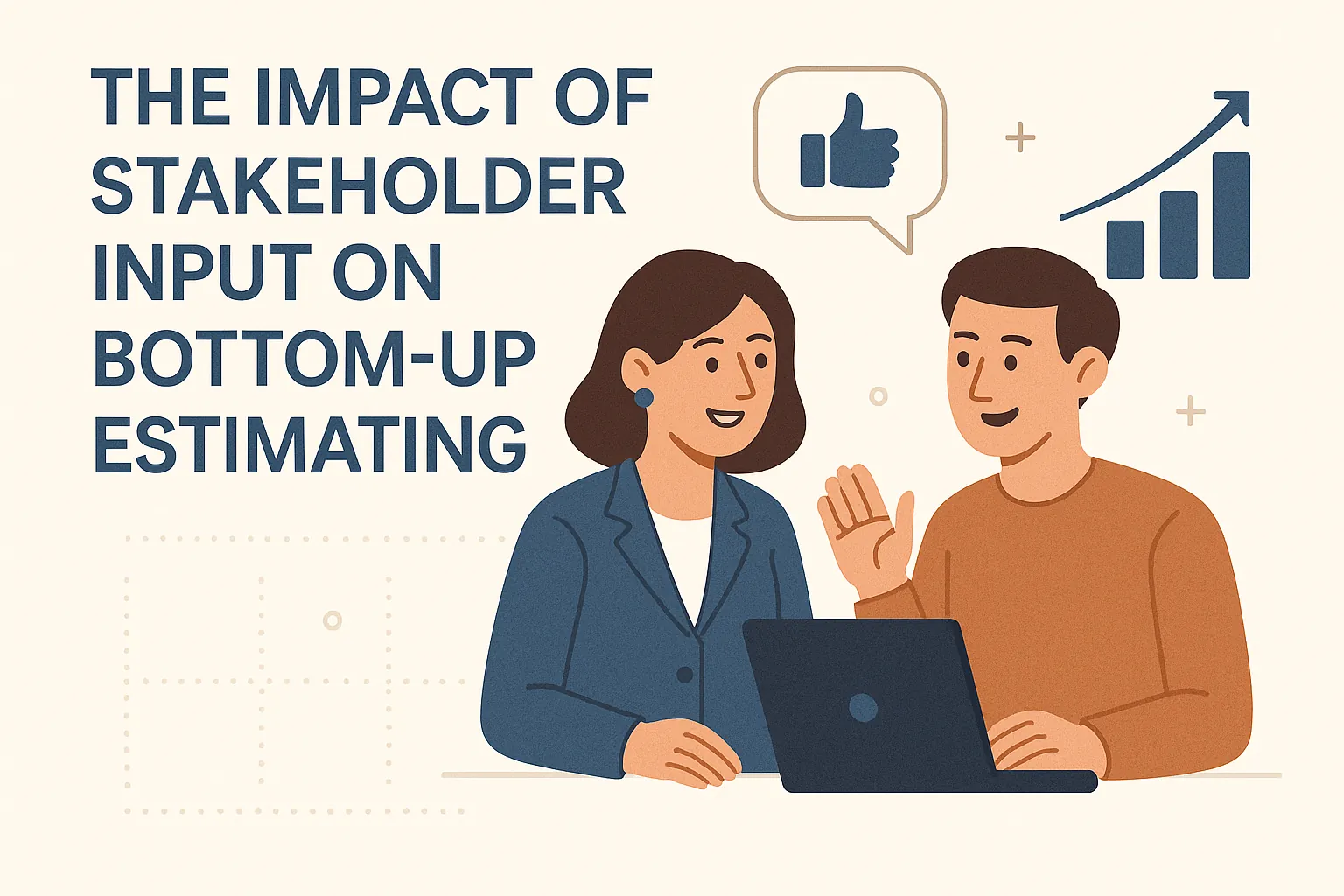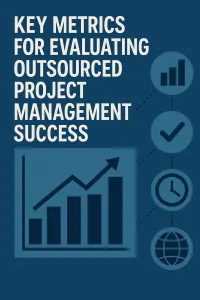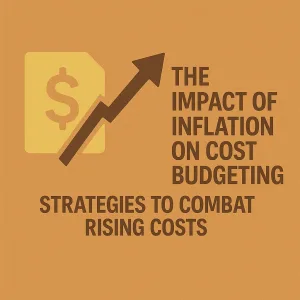Introduction
Accurate estimation is crucial for the successful execution and completion of projects. One of the most effective techniques for achieving precise estimates is bottom-up estimating. This method involves breaking down a project into its smallest components, allowing project managers to estimate costs and durations at a granular level. By aggregating these detailed estimates, a comprehensive overview of the project’s financial and temporal requirements is formed, which is particularly beneficial for complex projects where precision is paramount [1][2].
Accurate estimates are not merely numbers on a spreadsheet; they are foundational to project success. They help in resource allocation, budgeting, and scheduling, ultimately influencing the project’s overall viability. When estimates are based on detailed analysis, the likelihood of meeting project deadlines and staying within budget increases significantly. This is essential for maintaining stakeholder trust and ensuring that project objectives are met [3][12].
Stakeholders play a pivotal role in the bottom-up estimating process. Their insights and feedback can enhance the accuracy of estimates by providing valuable information about project requirements, potential risks, and resource availability. Engaging stakeholders early in the estimating phase fosters a collaborative environment where their expertise can be leveraged to identify all necessary components of the project. This collaboration not only enriches the estimating process but also helps in aligning project goals with stakeholder expectations, thereby increasing the chances of project success [5][10].
Understanding Bottom-Up Estimating
Bottom-up estimating is a crucial technique in project management that allows for a detailed and accurate assessment of project costs, durations, and resource requirements. This method involves breaking down a project into its smallest components, enabling project managers to create precise estimates based on individual tasks or work packages. Here’s a comprehensive overview of the steps involved, the benefits of this approach, and the common challenges faced during the estimating process.
Steps Involved in Bottom-Up Estimating
- Task Identification: The first step is to identify all the tasks required to complete the project. This involves breaking down the project into manageable units of work, ensuring that no critical components are overlooked [5].
- Estimating Resources: For each identified task, project managers must estimate the resources needed, including personnel, materials, and equipment. This granular approach allows for a more accurate assessment of what is required for each component [11].
- Duration Estimation: After determining the resources, the next step is to estimate how long each task will take. This involves considering the complexity of the task and the availability of resources [11].
- Cost Estimation: Finally, project managers calculate the costs associated with each task, aggregating these estimates to arrive at a total project cost. This detailed breakdown helps in understanding the financial implications of the project [8].
- Aggregation of Estimates: Once all individual estimates are completed, they are aggregated to form a comprehensive overview of the project’s total cost, duration, and resource requirements [4].
Benefits of Using a Bottom-Up Approach
- Accuracy: One of the primary advantages of bottom-up estimating is its high level of accuracy. By assessing each component in detail, project managers can create more reliable estimates, which can lead to better project planning and execution [2][6].
- Risk Reduction: This method helps in identifying potential risks early in the project lifecycle. By understanding the specifics of each task, project managers can develop strategies to mitigate risks associated with cost overruns or delays [3].
- Enhanced Stakeholder Engagement: Involving team members and stakeholders in the estimating process fosters collaboration and ensures that all perspectives are considered. This can lead to more realistic estimates and increased buy-in from stakeholders [10].
Common Challenges Faced During the Bottom-Up Estimating Process
- Time-Consuming: One of the significant drawbacks of bottom-up estimating is that it can be very time-consuming. The detailed nature of the process requires substantial effort and resources, which may not be feasible for all projects, especially those with tight deadlines [7].
- Complexity: Managing the intricacies of numerous tasks and their interdependencies can be challenging. Project managers must ensure that all components are accurately estimated and that the aggregation process is handled correctly to avoid discrepancies [8].
- Dependence on Team Input: The accuracy of bottom-up estimates heavily relies on the input from team members. If the team lacks experience or if there is insufficient communication, the estimates may be flawed, leading to potential project issues [6].
The Role of Stakeholders in Bottom-Up Estimating
In project management, the process of bottom-up estimating is significantly influenced by the input and expertise of stakeholders. This section will explore the various types of stakeholders involved in projects, how their expertise can enhance estimates, and the potential impact of their feedback on project outcomes.
Identifying Different Types of Stakeholders
Stakeholders are individuals or groups that have an interest or influence in the project. They can be broadly classified into two primary categories:
- Internal Stakeholders: This group includes team members, project managers, and executives within the organization. Their insights are crucial as they are directly involved in the project execution and understand the internal processes and capabilities.
- External Stakeholders: This category encompasses clients, suppliers, regulatory bodies, and the community affected by the project. Their perspectives can provide valuable context and requirements that may not be apparent to the internal team.
Understanding the diverse roles and interests of these stakeholders is essential for effective bottom-up estimating, as their input can lead to more accurate and comprehensive estimates [12].
Enhancing Estimates Through Stakeholder Expertise
Stakeholders often possess specialized knowledge and experience that can significantly enhance the accuracy of project estimates. For instance:
- Technical Experts: Team members with technical expertise can provide detailed insights into the resources and time required for specific tasks, ensuring that estimates reflect realistic expectations.
- Clients and Users: Their feedback can clarify project requirements and priorities, helping to align estimates with actual needs and expectations.
- Regulatory Bodies: Understanding compliance requirements from these stakeholders can prevent underestimating the time and resources needed for approvals and inspections.
Incorporating this expertise into the estimating process not only improves accuracy but also fosters a sense of ownership among stakeholders, which can lead to increased commitment to the project’s success [11][15].
The Impact of Stakeholder Feedback on Project Outcomes
The feedback from stakeholders can have a profound impact on project outcomes. Here are some key considerations:
- Increased Accuracy: By integrating stakeholder input, project managers can create more precise estimates that reflect the realities of the project environment, reducing the likelihood of budget overruns and missed deadlines [4].
- Enhanced Buy-In: When stakeholders see their feedback being valued and incorporated, it can lead to greater buy-in and support for the project. This is crucial for maintaining momentum and ensuring that resources are allocated effectively [10].
- Risk Mitigation: Stakeholder insights can help identify potential risks early in the estimating process, allowing project managers to develop strategies to mitigate these risks before they impact the project [13].
Effective Strategies for Incorporating Stakeholder Feedback
Incorporating stakeholder feedback into bottom-up estimating is essential for project managers aiming to create accurate and reliable project estimates. Here are some actionable strategies to effectively gather and utilize stakeholder input:
- Establish Clear Communication Channels: It is crucial to define and maintain open lines of communication with stakeholders. This ensures that their insights and concerns are heard and addressed promptly. Regular updates and feedback sessions can help keep stakeholders engaged and informed about the estimating process, fostering a collaborative environment where their input is valued [5][6].
- Utilize Workshops and Brainstorming Sessions: Organizing workshops and brainstorming sessions can be an effective way to gather diverse perspectives from stakeholders. These collaborative meetings allow stakeholders to share their experiences and expectations, which can lead to a more comprehensive understanding of project requirements. By involving stakeholders in the estimating process, project managers can uncover potential risks and opportunities that may not have been considered otherwise [3][4].
- Implement Feedback Loops: Creating feedback loops is essential for continuously refining estimates based on stakeholder insights. This can be achieved by integrating regular feedback mechanisms, such as post-project surveys or review meetings, into the project lifecycle. By analyzing the feedback collected, project managers can identify trends and areas for improvement, ensuring that estimates remain relevant and accurate throughout the project [9][6].
By employing these strategies, project managers can enhance the accuracy of their bottom-up estimates while fostering stronger relationships with stakeholders. This collaborative approach not only leads to more informed decision-making but also increases stakeholder buy-in and commitment to the project, ultimately contributing to its success [5][6].
Tools and Techniques for Gathering Stakeholder Input
Incorporating stakeholder feedback into bottom-up estimating is crucial for creating accurate project estimates and fostering collaboration. Here are some effective tools and techniques that project managers can utilize to gather valuable input from stakeholders:
- Project Management Software: Utilizing project management software can significantly enhance stakeholder collaboration. Many platforms offer features that allow stakeholders to contribute directly to project plans, timelines, and budgets. Tools like Asana, Trello, and Microsoft Project enable real-time updates and feedback, ensuring that all parties are aligned and informed throughout the estimating process. This transparency helps in building trust and accountability among stakeholders, which is essential for successful project outcomes [1][4].
- Surveys and Questionnaires: Surveys and questionnaires are effective methods for collecting quantitative feedback from stakeholders. By designing targeted questions that address specific aspects of the project, project managers can gather insights on resource needs, potential risks, and time estimates. This data can then be analyzed to refine estimates and ensure they reflect the collective input of all stakeholders. Online tools like Google Forms or SurveyMonkey can facilitate this process, making it easy to distribute and analyze responses [2][8].
- Regular Check-Ins and Updates: Establishing a routine for regular check-ins and updates with stakeholders is vital for maintaining open lines of communication. These meetings can be used to discuss progress, address concerns, and gather ongoing feedback. By scheduling these interactions, project managers can ensure that stakeholder input is continuously integrated into the estimating process, allowing for adjustments as new information arises. This proactive approach not only enhances the accuracy of estimates but also strengthens stakeholder engagement and commitment to the project [3][5].
Common Pitfalls to Avoid
Incorporating stakeholder feedback into bottom-up estimating is crucial for accurate project planning and execution. However, project managers often encounter several pitfalls that can undermine the effectiveness of this approach. Here are some common mistakes to be aware of:
- Underestimating Stakeholder Involvement: One of the most significant pitfalls is failing to recognize the extent of stakeholder involvement required in the estimating process. Stakeholders can provide valuable insights that enhance the accuracy of estimates, but if their input is underestimated or overlooked, it can lead to unrealistic projections and project delays. Engaging stakeholders early and consistently throughout the estimating process is essential to ensure their perspectives are adequately considered [1][7].
- Ignoring Conflicting Stakeholder Opinions: Conflicting opinions among stakeholders can pose a challenge during the estimating phase. When project managers ignore these differing viewpoints, they risk making decisions that do not align with the overall project goals or stakeholder expectations. This can lead to dissatisfaction and a lack of support from key stakeholders, ultimately jeopardizing the project’s success. It is vital to facilitate open discussions and seek consensus among stakeholders to address conflicts and integrate diverse perspectives into the estimates [4][10].
- Balancing Feedback with Project Constraints: While stakeholder feedback is invaluable, it is equally important to balance this input with the project’s constraints, such as budget, timeline, and resources. Overemphasizing stakeholder desires without considering these limitations can result in scope creep and unrealistic expectations. Project managers should strive to find a middle ground that respects stakeholder input while adhering to the project’s practical boundaries. This balance is crucial for maintaining project viability and stakeholder trust [2][9].
By being aware of these common pitfalls, project managers can enhance their bottom-up estimating processes, leading to more accurate estimates and successful project outcomes. Engaging stakeholders effectively and addressing their feedback while considering project constraints will ultimately contribute to a more robust project management strategy.
Conclusion
Incorporating stakeholder input into bottom-up estimating is crucial for the success of any project. Throughout this discussion, we have highlighted several key points that underscore the importance of this collaborative approach:
- Transparency and Trust: Engaging stakeholders in the estimating process fosters transparency, allowing them to understand the basis of estimates and how they were derived. This transparency can significantly enhance stakeholder confidence in the project, as they can see the detailed breakdown of tasks and resources involved [1][5].
- Risk Mitigation: By involving stakeholders early on, project managers can identify potential risks and issues from the outset. This proactive engagement allows for better planning and resource allocation, ultimately reducing the overall risk associated with each project phase [2][3].
- Enhanced Accuracy: Stakeholders often possess valuable insights and expertise that can lead to more accurate estimates. Their input can help project managers refine their estimates based on real-world experiences and expectations, which is particularly beneficial in complex projects [6][8].
- Increased Productivity: When stakeholders are actively involved, the resulting estimates tend to be more precise, enabling efficient resource allocation and boosting overall productivity. This collaborative effort ensures that the project team is well-equipped to meet the project’s demands [8][9].
To maximize the benefits of stakeholder engagement in bottom-up estimating, project managers should adopt best practices such as:
- Regular Communication: Establishing open lines of communication with stakeholders throughout the project lifecycle ensures that their feedback is continuously integrated into the estimating process.
- Structured Feedback Mechanisms: Implementing structured methods for gathering stakeholder input, such as surveys or workshops, can facilitate more effective collaboration and ensure that all voices are heard.
- Iterative Review: Regularly revisiting estimates with stakeholders allows for adjustments based on new information or changing project dynamics, ensuring that estimates remain relevant and accurate.
In conclusion, the integration of stakeholder feedback into bottom-up estimating not only enhances the accuracy of project estimates but also builds a foundation of trust and collaboration. Project managers are encouraged to proactively engage stakeholders, leveraging their insights to create more robust and reliable project plans. By doing so, they can significantly improve project outcomes and foster a culture of collaboration that benefits all parties involved.
Find out more about Shaun Stoltz https://www.shaunstoltz.com/about/.
This post was written by an AI and reviewed/edited by a human.



